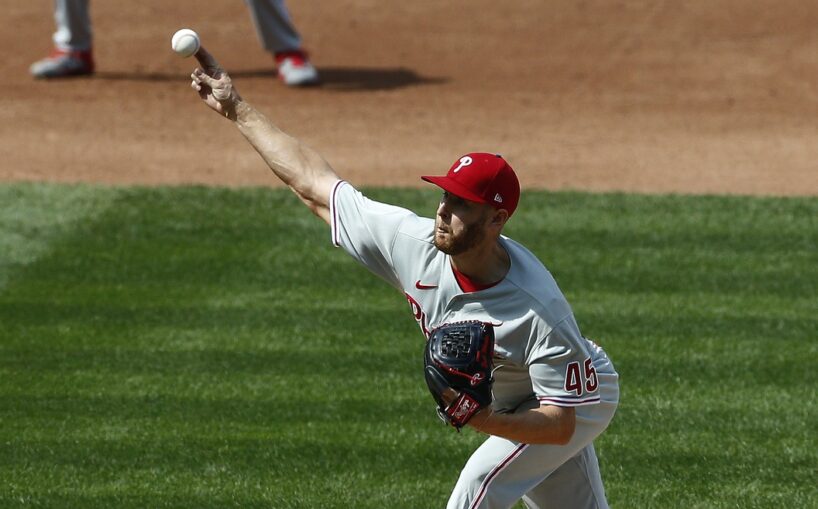
Spanning across 2015-2016, the New York Mets featured one of the top starting rotations in the majors and made the postseason in back-to-back seasons because of their elite pitching staff, however, starter Zack Wheeler‘s departure in 2019 created a massive hole that still hasn’t been filled.
After spending nine seasons inside the Mets’ organization, Wheeler hit the open market following the 2019 campaign, and since he posted a career-best 4.7 fWAR rating during that same season, the now 31-year-old had plenty of suitors willing to pay top dollar for his services. As a result, he was ultimately able to choose his next destination for the first time in his career.
The only problem with that situation is that the 6’4″ hurler reportedly didn’t receive an offer from New York, as former general manager Brodie Van Wagenen, along with The Wilpon Family, decided against spending a significant amount of money on the former first-round selection – a decision they’d live to regret.
Since Wheeler was free to sign elsewhere, the right-hander eventually settled on the Philadelphia Phillies and signed a five-year, $118 million contract. Fast-forward to this season, the 2021 National League All-Star hasn’t missed a beat and has continued to serve as a front-line starter, but this time, for a division rival.
If losing Wheeler to the Phillies wasn’t bad enough, the Mets recently received a painful reminder of his dominating talents as he threw a complete-game shutout against them on Sunday. Now removed from first place in the NL East Division, this team has seemingly hit rock bottom, which begs the question, what would’ve happened if they re-signed the impact starter rather than letting him walk for nothing?
This is probably something the fanbase has already wondered themselves, but the significance of this question has only increased since the emerging star left The Big Apple two off-seasons ago. Since then, this club’s starting rotation hasn’t been nearly as productive compared to previous seasons, especially since the front office has struggled to locate a game-altering starter behind ace Jacob deGrom.

Credit: Wendell Cruz-USA TODAY Sports
Along with failing to find a suitable replacement for Wheeler, which was to be expected, he’s also flourished since joining the Phillies and is currently enjoying the best statistical performance of his entire career, allowing him to transform into one of the top-producing starters over the last two seasons.
Set to prove his doubters wrong, the former top prospect is tied for the best xFIP- (71) and has recorded the highest fWAR rating (7.6), the best FIP (2.67) and FIP- (60), the second-best xFIP (3.07), the third-best ERA- (61) and is tied for the fourth-best ERA (2.58) among all qualified starters since 2020, according to FanGraphs.com.
For the sake of this article, hypothetically, let’s say the Mets opted to make a serious run at Wheeler and ultimately re-signed him to the same contract he agreed to with the Phillies, locking the righty up through the 2024 season.
If this had occurred, there likely would’ve been no reason for management to bring in veteran Rick Porcello, although they still probably would’ve acquired fellow starter, Michael Wacha.
Still, even with Wacha on the roster, this team’s starting rotation could’ve been an area of strength last season, as it would’ve also included deGrom, Wheeler, David Peterson, and Steven Matz. That’s a fairly reliable rotation even if Matz still endured his troubling woes during the 60-game schedule.
Considering Porcello posted a 1-7 record, a 5.64 ERA, a 5.24 xERA, a 3.33 FIP, a 4.38 xFIP, and a 1.7 fWAR rating over his 59.0 innings of work, removing him from the starting rotation may have allowed the Mets to make a more competitive push at one of the two NL Wild Card spots.
While it’s unclear if keeping Wheeler would’ve allowed them to break their current playoff drought, given that he created a 4-2 record, a 2.92 ERA, a 3.55 xERA, a 3.22 FIP, a 3.76 xFIP and a 2.0 fWAR rating through 71.0 innings, chances are they wouldn’t have finished three games back of the second WC seed.
Financially, ownership likely wouldn’t have needed to worry about exceeding the $210 million luxury tax, at least in 2020, as the club’s payroll would’ve finished just below that threshold. Without Porcello’s $10 million salary on the books, the front office could’ve possessed just over $24.8 million in tax space, according to Cot’s Baseball Contracts.
Since Wheeler earned $21.5 million last season, adding his salary to New York’s payroll wouldn’t have pushed them over the edge, leaving the team approximately $3.3 million in tax space.
Moving ahead to this season, there likely wouldn’t have been a need to pursue pitcher Taijuan Walker in free agency after acquiring Carlos Carrasco and re-signing Marcus Stroman. In turn, management could’ve saved $9 million against the luxury tax, allowing them to utilize those savings elsewhere.
Taking into account Wheeler’s $22.5 million salary in 2021, even without Walker on the roster, the Mets would’ve slightly exceeded the luxury tax by approximately $128,000. But with owner Steve Cohen at the helm, that’s a decision he likely would’ve been willing to make, especially since it could’ve made his team a superior threat in the NL East.
Though this move probably wouldn’t have made an impact on the club’s struggling offense, featuring a rotation that consisted of deGrom, Wheeler, Carrasco, Stroman and Peterson could’ve helped relieve some of that frustration. Obviously, three of these hurlers have missed large chunks of the season, however, the hard-throwing righty would be able to carry the load with the team’s ace on the injured list.
As for what’s happening in reality, Walker hasn’t stepped up with deGrom unavailable and is starting to become a liability on the mound, as he’s produced an alarming 6.70 ERA, 6.96 FIP, 5.22 xFIP and has allowed 13 home runs over his last nine starts.
With the Mets currently competing against the Phillies – and the Atlanta Braves – for top spot in the NL East, their chances of capturing the division title would almost certainly increase dramatically if they weren’t battling against Wheeler and had him on their side. Given the emergence of rookie Tylor Megill, along with the potential return of Noah Syndergaard, starting pitching is an area that could’ve carried this team down the stretch.
Taking this a step further, if deGrom returned to action in September like expected, and Carrasco was fully stretched out, their rotation would’ve likely mirrored the ones that dominated the competition throughout the 2015 and 2016 postseasons.
But unfortunately, all of this will forever be known as a what-if scenario as the previous Mets’ brass allowed Wheeler to slip through their fingers, and for the fanbase, that situation will likely continue to haunt them over the next several years.














